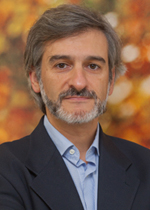Gustavo González Gaitano, Full Professor of Chemistry Physics in the School of Sciences of the University of Navarra.
Chemistry minimalist: nanomachines
The Swedish Academy has awarded this year's award Nobel Prize for Chemistry to Jean-Pierre Sauvage (Université de Strasbourg), Sir James Fraser Stoddart (Northwestern University) and Bernard L. Feringa (University of Groningen) for design and synthesis of molecular machines.
 My first meeting with molecular machines came during my doctoral thesis , when I was studying how certain detergent molecules were able to pass through a "hoop" (a cyclic molecule), and even thread many of these hoops into longer ones, like pearls on a necklace, a debatable activity in terms of usefulness internship and potential employment opportunities. At that time, one of the laureates, Sir Fraser Stoddart, was already defining the molecular machines as "a set of molecular components designed to develop machine-like movements as result of an external stimulus".
My first meeting with molecular machines came during my doctoral thesis , when I was studying how certain detergent molecules were able to pass through a "hoop" (a cyclic molecule), and even thread many of these hoops into longer ones, like pearls on a necklace, a debatable activity in terms of usefulness internship and potential employment opportunities. At that time, one of the laureates, Sir Fraser Stoddart, was already defining the molecular machines as "a set of molecular components designed to develop machine-like movements as result of an external stimulus".
From then until now I have had the opportunity to attend to some of his lectures, always inspiring. And the 2016 Nobel Prize of Chemistry belongs to the category of awards that are forged over time. The first laureate, Jean-Pierre Sauvage, and his collaborators at the high school Louis Pasteur, took the first step in the construction of nanomachines when they discovered a way to connect two cyclic molecules, in the same way that a magician is able to interlock two rings, to form a catenane. The significance of this achievement lay in the ability to control the reaction Chemistry to arrange the molecules in space in the desired way, a breakthrough that was followed by other more exotic and convoluted Structures . Then, in 1991, Sir Fraser Stoddart - working at the University of Sheffield - went a step further by creating a new structure in which a cyclic molecule was trapped in a polymer whose ends were capped(rotaxane). When an electrical stimulus was applied, the captive molecule could rotate, like a diabolo, or move in both directions, like an elevator, managing to lift a molecule between two "plants" separated by just 0.7 nanometers.
It would be years yet before Bernard Ferninga, the third recipient of the award, managed to "motor" these tiny machines, spinning a molecule indefinitely in a single direction with UV light and thus moving much larger objects. More recently, his group has been able to power a "nanocar" consisting of four wheels and a chassis, and many other ingenious devices have appeared in the trade journals.
In a world in which the devices that make our lives more comfortable are evolving towards miniaturization, these scientists have "hit the ceiling" by designing and operating the smallest possible machines. Little thing? Certainly not. Compared to the machines that changed the world in the industrial revolution of the 19th century, molecular machines are at a very early stage. Nevertheless, we may be at the beginning of a new industrial revolution. The future will show us how these small devices become an integral part of our lives.
